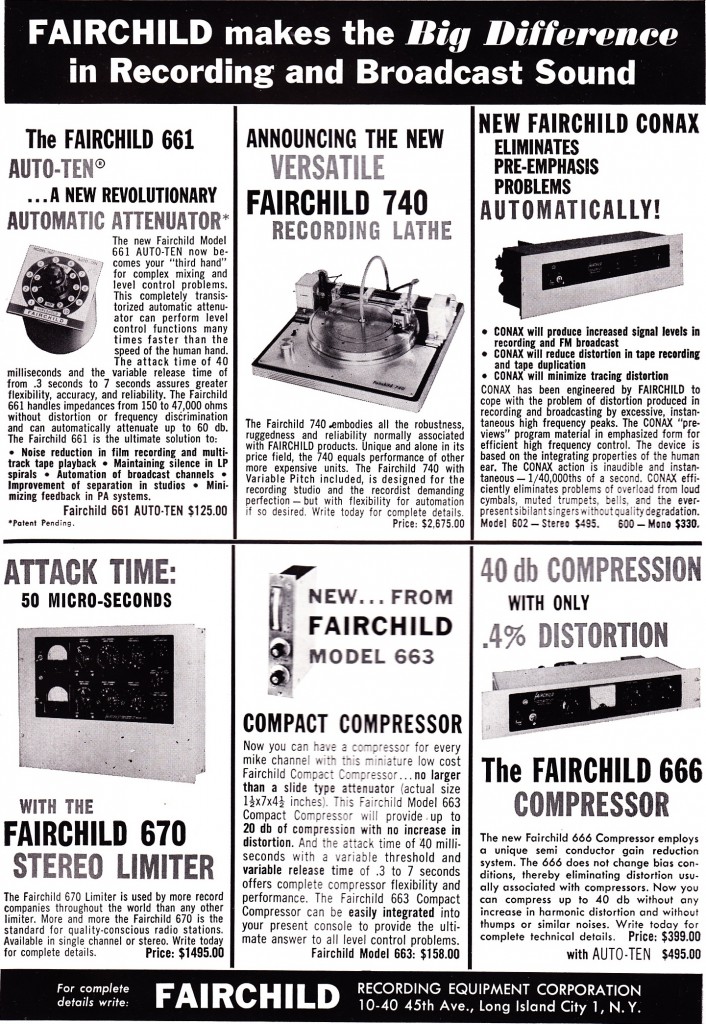 Above: the Fairchild 661 Auto-ten (a noise gate, apparently), 740 Lathe, 602 and 600 Conax (de-essers, apparently), 670 stereo limiter, 663 Compact console channel compressor, and 666 compressor, which wants you to know that it is emphatically NOT a vari-mu compressor.
Above: the Fairchild 661 Auto-ten (a noise gate, apparently), 740 Lathe, 602 and 600 Conax (de-essers, apparently), 670 stereo limiter, 663 Compact console channel compressor, and 666 compressor, which wants you to know that it is emphatically NOT a vari-mu compressor.
Today on PS dot com: some pro audio gear from NYC’s legendary Fairchild Recording Equipment Corporation. This post will strictly be a scan of marketing materials from the era, as I have never used or serviced any of these pieces (other than a 670 clone). A PS Dot Com reader alerted me to the fascinating story of Sherman Fairchild, the man behind the corporation that brought the world this very advanced audio technology: you will not be surprised to learn that he had roots in the aviation industry and a key connection to IBM. See the comments section or click here to learn more.
this gets a little lengthy so click below to READ ON…
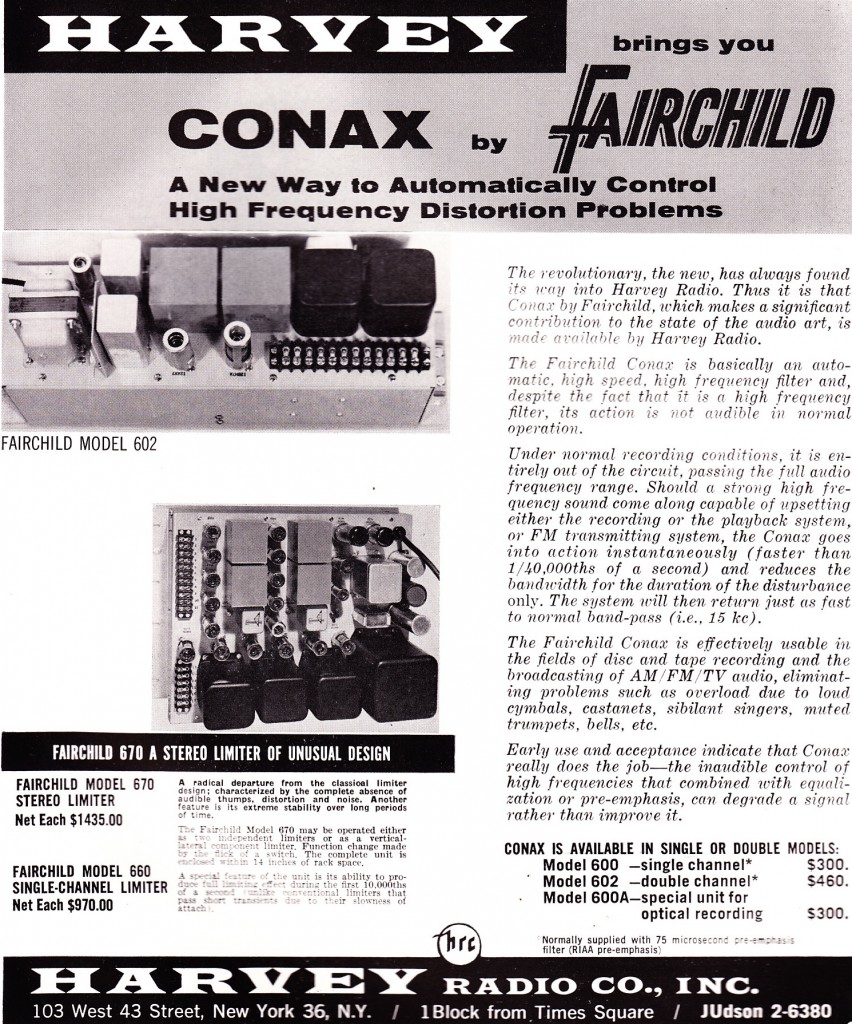 Above: the 602 Conax and 670 limiter.
Above: the 602 Conax and 670 limiter.
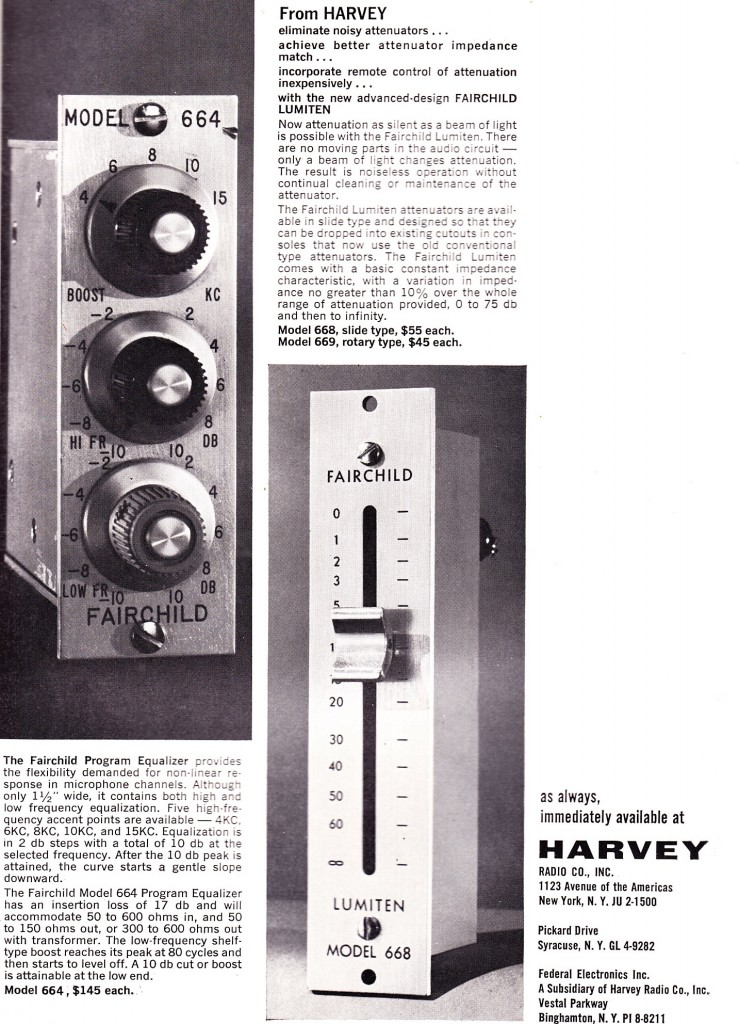 Above: the Fairchild 664 console channel equalizer. A nice-looking example (with integral gain make-up stage!) is on eBay right now for a pretty reasonable price. The 668/669 Lumiten is an attenuator that uses a light source and LDR to regulate gain. See the ‘Comments’ section of this post for much more information regarding the Lumiten.
Above: the Fairchild 664 console channel equalizer. A nice-looking example (with integral gain make-up stage!) is on eBay right now for a pretty reasonable price. The 668/669 Lumiten is an attenuator that uses a light source and LDR to regulate gain. See the ‘Comments’ section of this post for much more information regarding the Lumiten.
Above: the Fairchild 740 lathe, 605 phono EQ, and 666/666A compressor.
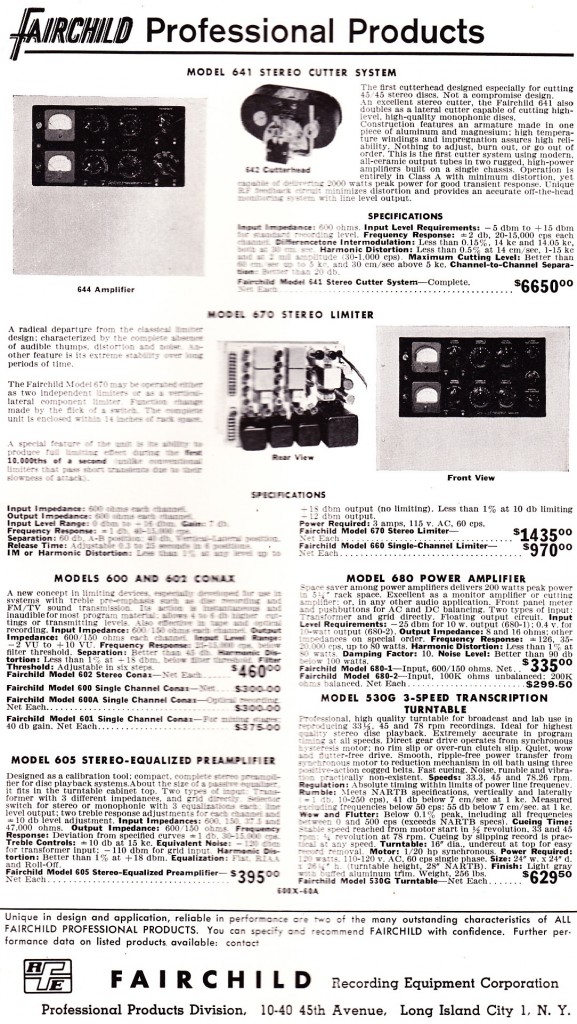 Above: the Fairchild 641 stereo cutter system, 670 stereo limiter, etc..
Above: the Fairchild 641 stereo cutter system, 670 stereo limiter, etc..
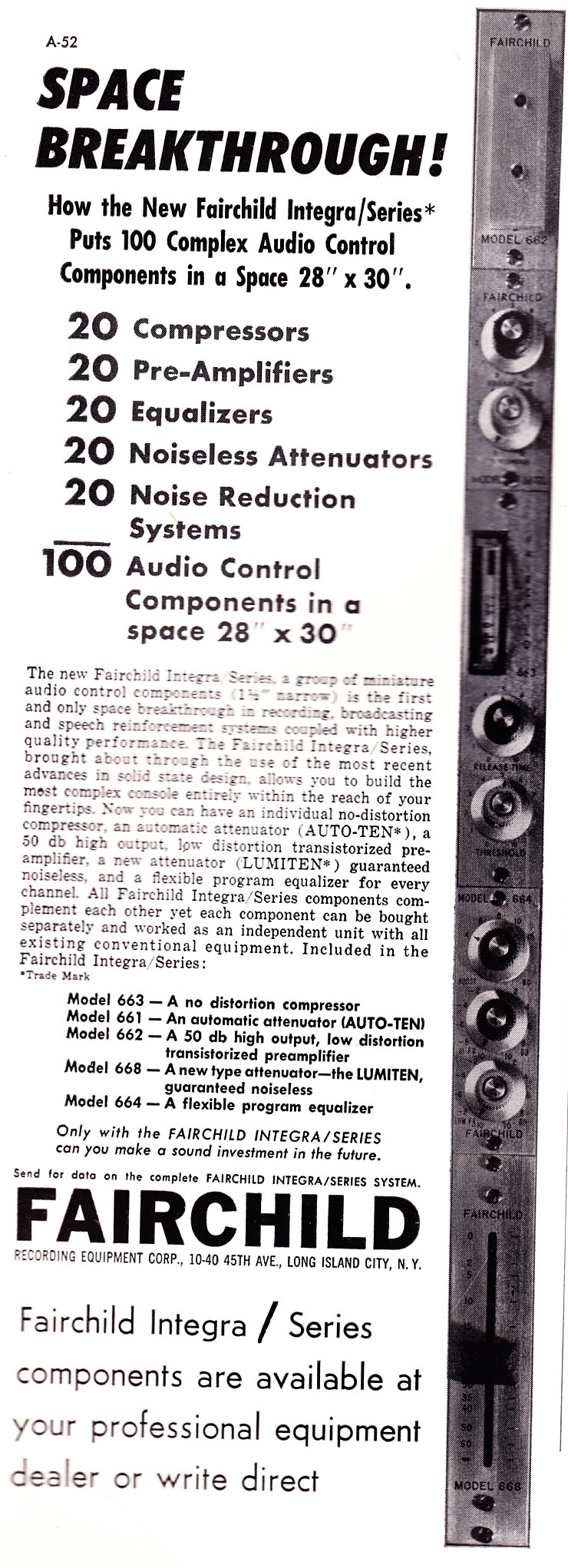 Above: the Fairchild Integra range of console channel modules circa 1963: For each channel on your board, you could have a 662 preamp, a 661 gate, a 664 equalizer, a 663 compressor, all controlled by a 668 noiseless Lumiten fader. This is some incredible technology considering the era. I gotta imagine that no intact Integra console still exists. Anyone out there ever work on one of these?
Above: the Fairchild Integra range of console channel modules circa 1963: For each channel on your board, you could have a 662 preamp, a 661 gate, a 664 equalizer, a 663 compressor, all controlled by a 668 noiseless Lumiten fader. This is some incredible technology considering the era. I gotta imagine that no intact Integra console still exists. Anyone out there ever work on one of these?
 And finally, some detail on the Conax. Based on the description here, it seems like this piece was high-frequency compressor…aka a de-esser.
And finally, some detail on the Conax. Based on the description here, it seems like this piece was high-frequency compressor…aka a de-esser.
For more Fairchild audio coverage on Preservation Sound… click this link.
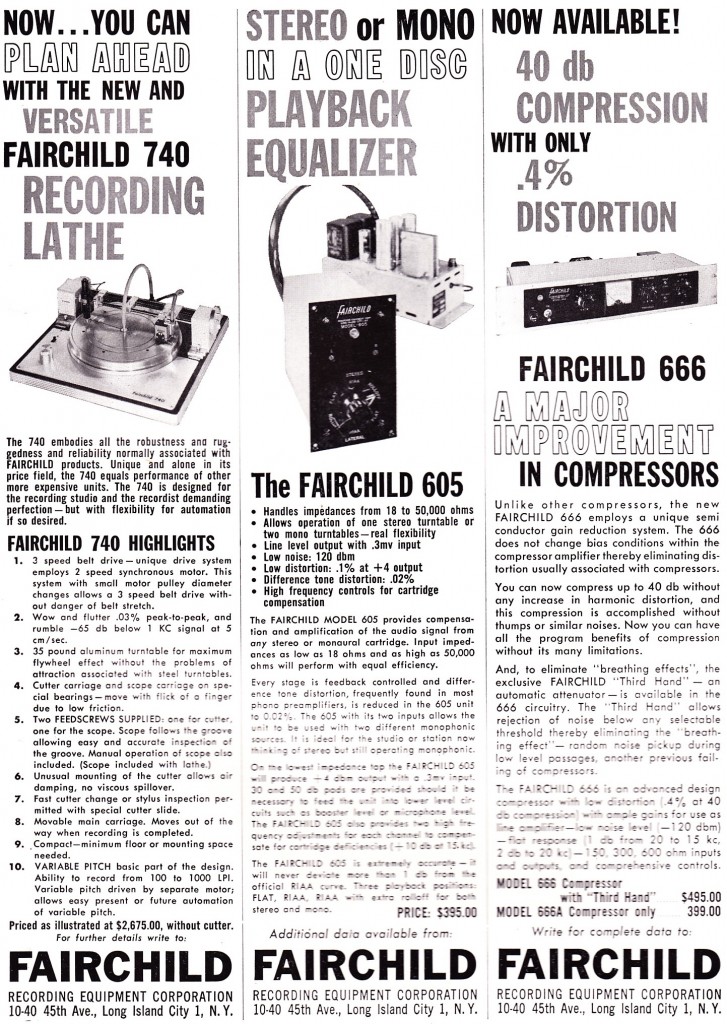
33 replies on “Fairchild Kit Of The Early 1960s”
The Fairchild Lumiten ™ was an attenuator that used a light source and LDR to control gain. It was a way to get around physical attenuator networks and stepped attenuators of the mid-60’s. The concept was developed by Bob Fine at Fine Recording (as explained by former Fairchild design engineer George Alexandrovich in his AES Oral History Project interview).
At the time the Lumiten was developed, there were no voltage-control amplifiers but there was already a desire to move away from bulky and somewhat fragile slider attenuators. When a Lumiten worked properly (industry veterans tell me that they were somewhat balky and fragile), it provided much smoother attenuation than 1/2-dB steps typical on physical attenuators. The slider was also cheap and easy to replace if someone spilled something on the console.
Today we have automated “control surfaces” that are digital encoders, so the Lumitens are as dated and ancient as Daven attenuators or ADM’s Slidex from the 70’s.
Fairchild’s corporate history is well worth studying. They built a lot of really good equipment for a lot of industries. It all came about because a pilot needed a camera for aerial photography, and they wound up building everything, any one of which would have been a remarkable product on its own.
Sherman Fairchild was a brilliant man and a widely diverse entrepreneur. He died a tragic death:
http://www.hankonealphoto.com/blog/2010/06/05/83-sherman-m-fairchild.html
Here is a bio of Fairchild detailing his industrial roots in aerial photography and bomb-sight design:
http://www.bcwarbirds.com/sherman_fairchild_bio.htm
He also manufactured airplanes for a period of time.
And, Fairchild Semiconductors is a descendant company, he was an early investor in those newfangled transistor things.
In the audio field, Fairchild at various times made: disk-recording systems (lathes, cutterheads and amplifiers); broadcast turntables, cartridges and preamplifiers (including a turntable that used a high-frequency oscillator to maintain speed accuracy); modular pieces to put together mixing consoles (and later complete mixers and consoles); various disk-cutting control systems like the Conax and optical bass limiter; compressors like the famous 670; and even tape machines in the late 40’s and early 50’s. Fairchild employed genius engineers like Norman Crowhurst, George Alexandrovich and Rein Narma. They threw a lot of unique ideas out there, and some worked very well.
There was a Time Magazine profile of Fairchild and his industrial empire in the early 60’s. Here is the article online (accessible only to Time subscribers):
http://www.time.com/time/magazine/article/0,9171,826520,00.html
and that issue’s cover showing Fairchild:
http://www.time.com/time/covers/0,16641,19600725,00.html
(Fairchild’s middle initial was M, not F)
Very interesting to find my name in the column about Fairchild and his empire. I worked for Sherman over 21 years and I designed good deal of equipment. I was running the company FRECO until Sherman’s death in 1971 and then I merged with Herman Post and his company ROBINS Industries and we moved to Hauppauge, 1/10 mile from my home. . I am still active in this field and I am the only one left it seems who can repair and re-build stereo and mono cutter heads. I have only repaired 169 sets. I am not an youngster, I have lived through WW2 and started my audio careen when I took apart Messerschmitt aircraft and pulled all RVP2000 pentode tubes out of it and started building amplifiers and radios. It was in 1945. I can not believe I am still here writing this to young guys who never recorded sound on wire recorder or spliced magnetic tape made from paper. Boy, did you miss lots of fun! Well, have fun you all button pushers and screen touchers. Just , get back to decent material for sound recording. Todays music is not good even for birds. By the way Sherman Fairchilds middle name was Milhouse and he lived in 17E 65 th street in Manhattan.
Mr. Alexandrovich, I salute you- a hero of electrical engineering design.
I had the opportunity to be a disc jockey at two Radio stations using Fairchild’s 663/664 optical EQ and Compressor, WVLK in Lexington KY & WKLO in Louisville KY . Herman Pipsqueek would sound like Mighty Joe Young with this processor. Joe Meek experimented with optical processing as evidenced by the hit record “Telstar” back in the early 60’s. I have one of his boxes and it’s reminiscent of the Fairchild duo.
I never soloed it but I got a lot of stick time in a neighbor’s Fairchild 24 with its Fairchild Ranger engine. He sold it and bought a Dehavilland Vampire that would run on heating oil, and sold that and bought a Bonanza. Like several warbird guys he was killed flying that Bonanza. When he bought it though, it had an electric prop with a vacuum tube controller, which he replaced with a McCauley or Hartzell. I have the tube control box in my garage now.
[…] preservationsound.com) Share this:Like this:LikeBe the first to like this post. Filed Under: gear Tagged With: […]
Rein Narma is still alive IIRC and would be a most fascinating interview. As I remember he built the famous 811 cutter head amplifier that used a GR toroid wound on a Variac core. It took a lot of moxie to make it work and a variant today with a better output transformer might make a great bass amp. The 811 has a mu of 160, being purposed as a zero bias Class B modulator and Class C RF final…but it’s still cheap and uses a common four pin socket (common as compared to many other transmitting types).
I bought a Fairchild stereo cutter amp from Bruce Martin in 1971. It had 4CX250B’s for output tubes. 250 watts per channel of really clean audio. The feedback circuit was defeated and it got used for a PA amp for a band in Pittsburgh (Crabshaw) that had been using a Shure Vocal Master. It must have weighed 250 lbs.
It was a lot louder and cleaner than the Shure. The roadie and sound guy was a big, strong lad.
[…] https://www.preservationsound.com/?p=4024 […]
Remaking the legendary FAIRCHILD 670 seems very hard, but it is still possible to find original parts from the 50s and 60s to make it sound authentic, it is possible and very successful, and without any compromise on the Audio side…
This is what I try to do, and hopefully will manage to help people carry-on their dreams of using exquisite 1950s pieces of equipment into the 21st century…
POM
Several clones of the 670 exist and as long as the basic physics are right there is no need to use ridiculous NOS parts, other than the remote control pentodes that are no longer made. You don’t need selenium rectifiers or caps with illegal and hazardous materials.
Besides which, the 670 is really only of use if you are cutting lacquers. It’s not a great recording compressor.
” not a great recording compressor” . I simply cannot agree. While it isnt your typical stereo linked unit, the 670 ( and the 660, and the 666 tube compressor, are all astounding, spectacular sounding recording devices.
a 670 is not a compressor, it’s a 20 to 1 limiter.
The 670 and the 660 are identical units, one dual channel and one mono. The 660’s were used Extensively on the Beatles recordings, and many major studios have one or more of these very expensive units, or wish they did.
Considering that they are probably the most expensive single dynamic control device, I think it’s safe to say that if you have ever used one, you probably love it for good reason.. However, these are complex pieces of gear , and if it isnt working correctly, it wont sound good.
It’s expensive because studio customers have been trained to ask for it. So studios all want them. But cheaper better solutions exist.
Yeah, name one.
Two of the five lathes used by Bell Sound Studios in New York throughout the 1960’s and up to about 1970 were Fairchilds, I presume the aforementioned Model 740 – and only used to cut 45’s. (The other three, of course, were ‘pitch knob’ Scullys.) This info came from one of that studio’s former mastering engineers, Joe Brescio, who actually worked on one of the two Fairchilds – as well as two of the Scullys.
I have the user manual for the Fairchild 600, would be interested in making a clone for use with my record cutting lathe.
But the schematic is missing the details on what is inside the 9 pin metal can, which applies bias and pre-emphasis to the control circuit.
Anyone have any idea what the components were in there and how they were connected to the 9 pin plug?
Steve,
My nephew just aquired a Fairchild Model 600. Any chance you could electonically copy that owners manual and provide him a copy?
Greg Anderson
a_pitch_and_a_putt@yahoo.com
How about trying here: http://steampoweredradio.com/pdf/fairchild/manuals/Model%20602%20CONAX%20Conaccelerator%20Dual%20Channel%20Manual.pdf.
Any chance that he can crack open the FL101 and draw out the diagram of what is inside the metal can? So I can compare it to the drawings of what I have been told is in the can.
The 602 manual differs in that it is 2 channel whereas the 600 is single channel only.
I have a spare FL101 from a 600.
let me know if you still need one.
Rick
All you sound engineers who are mentioning my name, I am still alive and remember few things from Fairchild years (1956-1975) If you need some advise and help, I have few schematics of equipment I have designed and I can help you. Although I am 84, but my memory bank is still active.
8/2/2014 Commack, NY
Hi George. Thanks for getting in touch. If you have any otherwise unavailable schematics that you’d like me to scan and upload, please get in touch. best wishes, c.
Hi George!
If you do have the schematic for the Connex Series Model 600 I would love a copy of it. I was pretty excited to see that it uses the same input transformer as the 660/670. I will be using it in conjunction with my 1959 Rek-O-Kut lathe.
My email is blackcircleradiodj@gmail.com
Best regards,
Mitch
Happy new year from France George !
Have you the schematics of the Fairchild Audio 662 Mic preamp ?
Best regards
Jean-Michel
Did fairchild ever offer any kits of their 255,260 or 275 amplifiers?
[…] And not much else of relevance. We apparently ran an advert for this very unit some years back (click here for that earlier post). So I was very excited to see that this unit, which is VERY buildable using off-the-shelf […]
DROOOL! Simple times and yet still amazing sound to this day.
Music is a relative perception / experience… remember, its Art after all!
I have a Fairchild Termo stylus 30013, opened the back up and no wires are soldered? appears never were does anyone know if it came this way??
The Fairchild story is a very interesting one indeed however, it does not exactly end there. As George Alexandrvich Sr. Noted, Fairchild was taken over by Robins Ind. and moved to Commack, NY. Well that’s where the story continues. That’s when I joined Fairchild about 1972. I was hired as a test Tec. and George was my boss. I worked there for about 10 years, advancing to project engineer continuing the wonderful Fairchild line of products. Thanks George for the great relationship and knowledge you passed on.
Around 1980 Herman Post decided he will sell the Fairchild division of Robins / Fairchild to three of his current employees. To this day that company still continues manufacturing, in the sound re enforcement industry under the name of ProTech Audio corp.
The Fairchild story is a very interesting one indeed however, it does not exactly end there. As George Alexandrvich Sr. Noted, Fairchild was taken over by Robins Ind. and moved to Commack, NY. Well that’s where the story continues. That’s when I joined Fairchild about 1972. I was hired as a test Tec. and George was my boss. I worked there for about 10 years, advancing to project engineer continuing the wonderful Fairchild line of products. Thanks George for the great relationship and knowledge you passed on.
Around 1980 Herman Post decided he will sell the Fairchild division of Robins to three of his current employees. To this day that company still continues manufacturing, in the sound re enforcement industry under the name of ProTech Audio corp.
Greetings, I have rescued from our loft a Fairchild Industrial products Type SS-35 Syncro Sound Carousel 35mm slide projector Model No.760-23 (220v) with built-in screen and audio cassette. Even has original HD transport case and I havent a clue what to do with it as I dont need it.
Any Ideas?
Thanks
Steve (UK. Somerset)